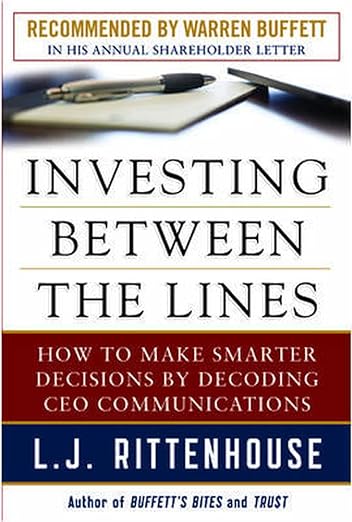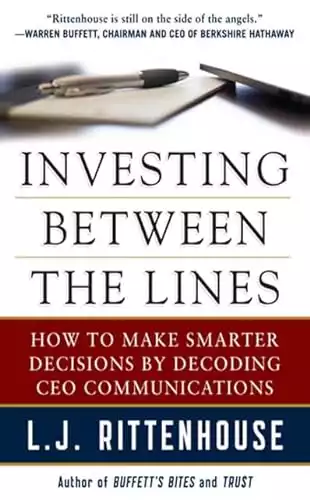Overview : Investing Between the Lines
- Book Title: Investing Between the Lines
- Author: L.J. Rittenhouse
- Publication Date: Initially published in 2012
- price: $15.55
- Pages: 904
Overview of the Book
This book is authored by Tim Koller, Marc Goedhart, and David Wessels, experts from McKinsey & Company. They specialize in corporate valuation, strategy, and financial analysis, bringing decades of practical and theoretical insights into creating value for companies.
Introduction
In the ever-evolving world of finance and investing, finding new angles to analyze potential investments is crucial. H. Richard Hainsworth's "Investing Between the Lines" offers a fresh perspective on evaluating companies, focusing on the often-overlooked aspect of corporate communication. This review delves into how Hainsworth's insights can reshape our approach to investment analysis and decision-making.
Book Summary
"Investing Between the Lines" challenges the traditional number-crunching approach to stock market analysis. Hainsworth, drawing from his extensive experience in financial analysis and ratings, argues that a company's communication style can be as revealing as its financial statements. The book introduces the concept of the "F-score," a tool designed to assess the trustworthiness and transparency of corporate communications. Key topics covered include:
- Decoding corporate language and its implications
- The relationship between communication style and company performance
- Integrating linguistic analysis with traditional financial metrics
- The psychological aspects of corporate communication
Analysis of Themes
The Power of Language in Investing
Hainsworth's central thesis revolves around the idea that how a company communicates can provide valuable insights into its operational efficiency, strategic foresight, and overall health. He argues that subtle linguistic cues, such as the use of jargon or abstract language, can indicate underlying issues or strengths within an organization.
Blending Qualitative and Quantitative Analysis
One of the book's strengths lies in its ability to bridge the gap between qualitative and quantitative analysis. By demonstrating how linguistic analysis can complement traditional financial metrics, Hainsworth provides a more holistic approach to investment evaluation.
The Digital Age and Corporate Transparency
While the book touches on the implications of digital communication channels, some readers might find themselves wanting more in-depth exploration of how social media and other digital platforms affect corporate transparency and investor relations in today's market.
Writing Style
Hainsworth's writing is engaging and accessible, striking a balance between informative content and conversational tone. This approach makes complex concepts digestible for beginners while offering deeper insights for seasoned investors. The author's passion for the subject shines through, making the reading experience both educational and enjoyable.
Strengths and Weaknesses
Strengths:
- Innovative approach to investment analysis
- Clear explanations supported by real-world examples
- Applicable to both novice and experienced investors
- Introduces the valuable "F-score" concept
Weaknesses:
- Could benefit from more in-depth coverage of digital communication impacts
- Some critics may argue it places too much emphasis on qualitative analysis
Comparison to Other Works
While many investment books focus solely on financial metrics or technical analysis, "Investing Between the Lines" stands out for its unique linguistic approach. It complements works like Benjamin Graham's "The Intelligent Investor" by adding a layer of qualitative analysis to fundamental investing principles. Compared to more recent works like Nassim Nicholas Taleb's "Fooled by Randomness," Hainsworth's book offers a more practical, applicable framework for everyday investors.
Key Quotes
"How a company communicates can be just as telling as the raw numbers they publish." "The most successful investors are those who can read between the lines, understanding not just what is being said, but also what is left unsaid."
Highlights from Investing Between the Lines
- Reading between the lines: Teaches how to interpret subtle signals in financial statements and reports.
- Uncovering hidden insights: Focuses on understanding what is not explicitly stated in corporate filings.
- Quantitative vs. qualitative analysis: Balances numerical data with the nuances of company culture and management.
- Market psychology: Explores how investor behavior influences stock prices beyond fundamentals.
- Earnings manipulation: Identifies red flags in financial reports that may indicate misleading or inflated results.
- Practical tools: Provides actionable techniques for better stock selection and risk management.
Conclusion
"Investing Between the Lines" is a groundbreaking work that challenges readers to think critically about the role of language in business and investing. By providing a framework for analyzing corporate communication, Hainsworth equips investors with an additional tool to make more informed decisions in today's complex financial markets. In an era where personal finance and market trends are increasingly influenced by factors beyond traditional metrics, this book offers valuable insights for navigating the modern investment landscape. Whether you're interested in stocks, bonds, or even emerging areas like cryptocurrencies, the principles outlined in "Investing Between the Lines" can help sharpen your analytical skills and potentially improve your investment outcomes. For those looking to expand their investment knowledge and gain a competitive edge in the market, "Investing Between the Lines" is an essential addition to your financial library.





